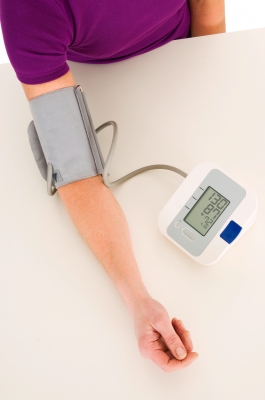Using Fully Automatic Home Blood Pressure Monitor
Blood pressure can be measured by a touch of a button. The cuff will inflate automatically, no manual efforts required. The systolic and diastolic blood pressures reading will be displayed digitally. Most of the blood pressure monitors devices display pulse reading too. Before start measuring the blood pressure at home, make sure you understood the working and numbers of blood pressure monitor.

You do not require any special skill set to operate automatic blood pressure monitor.
Steps to follow while measuring the blood pressure:
- Take reading at the same time of the day such as early in the morning and before going to bed. This will help you to maintain consistency and compare the readings without variations.
- Provide 30 minutes gap between activities such as eating food, coffee or alcohol, exercise, smoking and measuring your blood pressure
- You need to be seated comfortably with back supported for 5 minutes without moving or talking. Be Relaxed. Keep your feet flat on the floor.
- The arm needs to be placed at the level of the heart. Make sure no tight cloth around the arm.
- Wrap the cuff around the arm over the brachial artery. It should be done neatly.
- Depending upon the type of monitor, you can either inflate the device manually or the monitor will inflate and deflate automatically.
- Repeat the process for three times with gap of atleast one minute and record all measurements (systolic, diastolic, pulse). Few of the monitors may have the memory to store the readings. You can them for maintaining the history of the measurements.
Few other tips to ensure accurate reading:
- Cuff fitting place an important role in providing accurate readings. Make sure the cuffs are of the right size and fits you well.
- Check that the monitor have been validated for accuracy.
- Take the monitor to your care provider and measure reading back to back from your care provider’s professional Sphygmomanometer and your own blood pressure monitor. This will confirm that the readings are accurate.
Using Manual Blood Pressure Monitor
Manual blood pressure monitors are used in hospitals mostly. A person should keep a gap of 30 minutes between activities such as eating food, exercise, running, climbing stairs and measuring blood pressure .
You need to be seated for 5 minutes without moving or talking. In a relaxed state. Keep feet flat on the floor.
The arm needs to be placed at the level of the heart. Make sure no tight cloth around the arm, wrap the cuff on the arm over the brachial artery. It should be done neatly.
Follow the following steps:
- Palpate the brachial artery to find the strongest pulse sound
- Place the Stethoscope over the brachial artery
- Inflate cuff, which is wrapped around the arm until you hear no sound through the stethoscope. The gauge should read 30-40 mmHg above the normal reading.
- Deflate cuff. The pressure should fall at 2-3 mmHg per second.
- The first rhythmic sound heard from the stethoscope is the systolic pressure.
- Note the gauge reading when rhythmic sound stops. This reading on the gauge will be diastolic pressure.
You can double check the accuracy by measuring blood pressure from both the arms and taking average of both the readings. Wait for five minutes before taking reading from another arm.
